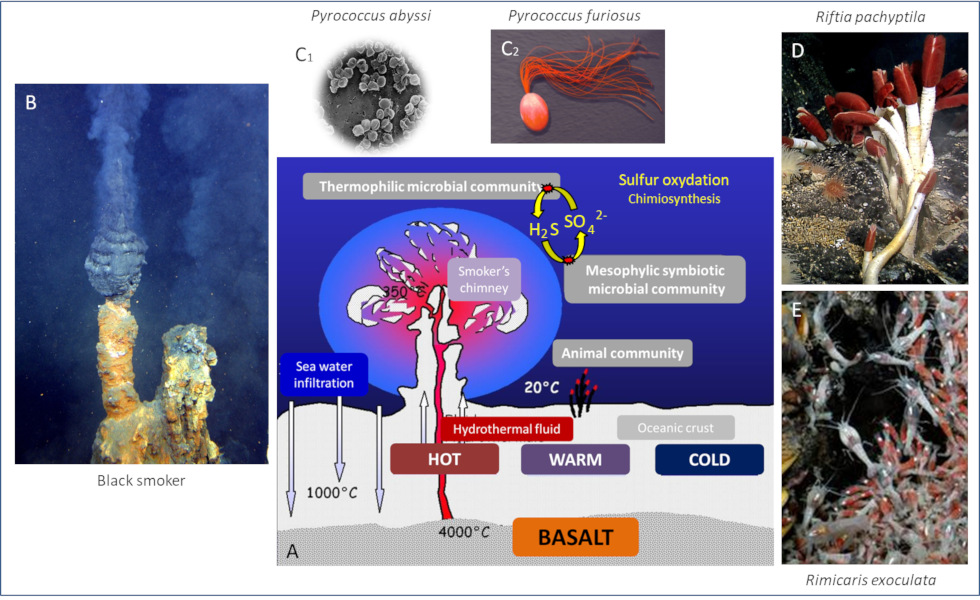Black smokers’ ecosystems
PDFPierre Vauclare, Institute of Structural Biology, Grenoble, France
Covering nearly two thirds of the Earth’s surface, the abyssal regions of the oceans have long been considered as spaces totally devoid of life due to the absence of light. However, the discovery in 1977 of the existence of hydrothermal vents, called black smokers, located on the Galápagos Ridge, totally modified our knowledge of ocean biology, but also our vision of the origin of life. This fascinating ecosystem is located along the mid-ocean ridges (Atlantic, Pacific and Indian Oceans), between 700 metres and more than 4000 metres deep, in areas with high volcanic activity. These sites then produce fluids with very high temperatures up to 410°C. It is in contact with cold oceanic water (< 4°C), that dissolved metals precipitate with sulphides to form the complex mineral structures known as black smokers. However, despite particularly hostile environmental conditions (lack of light, high temperatures and extreme pressures that can exceed 420 kg/cm2), these hydrothermal springs shelter, in their vicinity, an exceptional marine ecosystem among the most productive. This discovery has generated numerous exploration campaigns that have led to the discovery of new species known as extremophiles with high endemism rates. Indeed, clam colonies measuring nearly 30 centimetres (Calyptogena magnifica and Bathymodiolus thermophilus) coexist with white crabs, shrimps (Rimicaris exoculata) and giant worms up to 2 metres long (Riftia pachyptila). Like any ecosystem, those of the hydrothermal springs of the abyss exchange matter and energy. At the base of the food chain of this complex ecosystem are very diverse thermophilic microbial communities (bacteria and archaea) with sulfo-oxidizing properties. Indeed, thanks to the energy not of light (photosynthesis [1]), but of the oxidation of hydrogen sulphides (H2S) which are rejected by hydrothermal fluids (chemosynthesis [2]), these microorganisms synthesize carbonaceous molecules. These are the primary source of organic matter essential for the development of the many animal communities living in this extreme environment, which is not conducive to life. Finally, it should be noted that these hydrothermal sources are a readily available source of energy and nutrients. Thus, knowing that the first life forms were probably chemotrophic [3], a possible hypothesis would be that the first bricks of life may have appeared on the ocean floor. This is an additional hypothesis to try to understand the origin of life on Earth [4], or even on other planetary systems.

Notes and references
[1] Photosynthesis: Synthesis of carbon molecules from the reduction of CO2 and water, thanks to light energy.
[2] Chemosynthesis: Synthesis of carbon molecules from the reduction of CO2, thanks to the energy produced by chemical reactions (oxidation of mineral compounds).
[3] Chemiotrophic: Refers to a bacterium that feeds on chemosynthesis.
[4] Academy of Sciences, under the direction of Roland Douce and Eric Postaire (2016) Les origines du vivant. Une équation à plusieurs inconnues; Collection Folio Essais (n° 620), Gallimard, ISBN: 9782070462292. (in french).
Additional references :
- Youtube video: Abyss – Ifremer
- Media library of the Sea
- Thesis: Genomic maintenance in the hyperthermophilic Archaea Pyrococcus abyssi – Julien Briffotaux (Hal, open archives)




